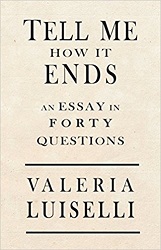
 Tell Me How It Ends
Tell Me How It EndsAn Essay in Forty Questions
Review posted August 12, 2017.
Coffee House Press, Minneapolis, 2017. 119 pages.
Starred Review
2017 Sonderbooks Standout: #5 General Nonfiction
This little book is not pretentious, calling itself an “essay” rather than a “book” – but it packs a punch.
I was expecting forty short chapters. Instead there are four chapters of varying lengths. The questions of the title refer to the forty questions on the intake questionnaire for unaccompanied child migrants used in the federal immigration court in New York City where the author began working as a volunteer interpreter in 2015.
Here’s how she describes this work:
My task there is a simple one: I interview children in court, following the intake questionnaire, and then translate their stories from Spanish to English.
But nothing is ever that simple. I hear words, spoken in the mouths of children, threaded in complex narratives. They are delivered with hesitance, sometimes distrust, always with fear. I have to transform them into written words, succinct sentences, and barren terms. The children’s stories are always shuffled, stuttered, always shattered beyond the repair of a narrative order. The problem with trying to tell their story is that it has no beginning, no middle, and no end.
I find I don’t have the heart to quote excerpts from the stories in this book from the children the author met. I’m left speechless. This book is eye-opening.
One of the stories is that of a teenage boy who found the same gang he was fleeing in Tegucigalpa was active in Hempstead, New York. Members of the gang beat him up in Hempstead, and another gang offers him protection if he’ll join them. He’s resisting.
She reflects on this story and on media reports about the child migrants coming from Central America:
Between Hempstead and Tegucigalpa there is a long chain of causes and effects. Both cities can be drawn on the same map: the map of violence related to drug trafficking. This fact is ignored, however, by almost all of the official reports. The media wouldn’t put Hempstead, a city in New York, on the same plane as one in Honduras. What a scandal! Official accounts in the United States – what circulates in the newspaper or on the radio, the message from Washington, and public opinion in general – almost always locate the dividing line between “civilization” and “barbarity” just below the Rio Grande….
The attitude in the United States toward child migrants is not always blatantly negative, but generally speaking, it is based on a kind of misunderstanding or voluntary ignorance. Debate around the matter has persistently and cynically overlooked the causes of the exodus. When causes are discussed, the general consensus and underlying assumption seem to be that the origins are circumscribed to “sending” countries and their many local problems. No one suggests that the causes are deeply embedded in our shared hemispheric history and are therefore not some distant problem in a foreign country that no one can locate on a map, but in fact a transnational problem that includes the United States – not as a distant observer or passive victim that must now deal with thousands of unwanted children arriving at the southern border, but rather as an active historical participant in the circumstances that generated that problem.
The belief that the migration of all of those children is “their” (the southern barbarians’) problem is often so deeply ingrained that “we” (the northern civilization) feel exempt from offering any solution. The devastation of the social fabric in Honduras, El Salvador, Guatemala, and other countries is often thought of as a Central American “gang violence” problem that must be kept on the far side of the border. There is little said, for example, of arms being trafficked from the United States into Mexico or Central America, legally or not; little mention of the fact that the consumption of drugs in the United States is what fundamentally fuels drug trafficking in the continent.
Here’s where she explains where the book got its title:
The children who cross Mexico and arrive at the U.S. border are not “immigrants,” not “illegals,” not merely “undocumented minors.” Those children are refugees of a war, and, as such, they should all have the right to asylum. But not all of them have it.
Tell me how it ends, Mamma, my daughter asks me.
I don’t know.
Tell me what happens next.
Sometimes I make up an ending, a happy one. But most of the time I just say:
I don’t know how it ends yet.
It is very possible that our policies in the United States and our actions as citizens will determine how these stories end. Which is a sobering thought.
Highly recommended reading. It’s not pleasant reading, but it is eye-opening and thought-provoking.
